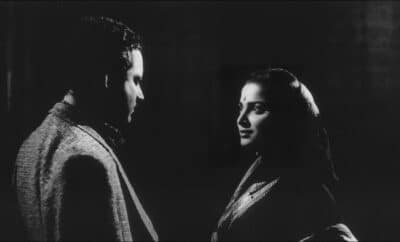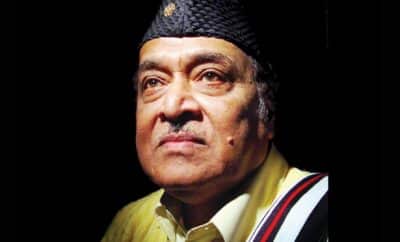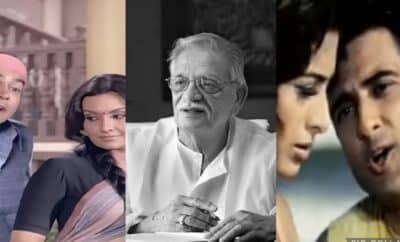Song Sketch
Naache Man Mora – Joie De Vivre of a Dancing Heart – Meri Surat Teri Aankhein
Dancing is one of the natural ways of expression of happiness, not just for human beings, but for many other creatures. But dancing with the feet is one thing, and dancing with the heart is another. Dancing with the feet may be to one’s chagrin, but almost everyone’s heart definitely dances in the times of joy. The song “Naache man mora magan tig dhaa dhigi dhigi” from Meri Surat Teri Aankhen (1963) is such an expression of a dancing heart or rather dancing with the heart.
The film revolves around misfortune and tragedy of an ugly man Pyare (Ashok Kumar), disowned and given away by his father immediately after birth and raised by a Muslim couple as own son. Pyare is shunned by the society that only welcomes beauty, despite the extraordinary singing talent that he is bestowed with. Pyare’s foster father Rahmat (Kanhaiyalal), just before breathing his last, reveals half the truth to him. Pyare later discovers his true roots with the help of Dr. Mathur (Tarun Bose), in whose hospital he was born. Dr. Mathur advises him to perform at the birthday party of Sudhir (Pyare’s younger brother from real parents, played by Pradeep Kumar), hoping that looking at his extraordinary talent, Pyare’s real father will overcome his dislike and own him. Pyare is naturally excited more than a little about meeting his real family; and his excitement brims over through this song. Dr. Mathur’s daughter and Sudhir’s girlfriend Kavita (Asha Parekh) dances to the song at the party.
The semi-classical composition based on raag Bhairavi with beautiful lyrics by Shailendra is adorned by S.D. Burman with his outstanding music and divine rendition by none other than Mohammed Rafi.
Pyare’s excitement becomes evident right from the first aalap. Then follow short pieces of tabla and santoor which act as suitable preambles to the mood of the song. Pyare then starts speaking up his dancing heart through Rafi’s voice –
Naache man mora magan tig dhaa dhigi dhigi
Badaraa ghir aaye, rut hai bhigi bhigi
Doesn’t this bring before your eyes a peacock dancing happily with the fan of his embellished plumage wide open in the cloudy and moist yet pleasant and enticing weather? What a fantastic description of a heart overflowing with delight in simple words!
After an interlude consisting of flute and sitar with tabla brilliantly fluttering around, he continues to express his feelings –
Kuhuke koyaliya, kahin door papiha pukare,
Jhoola jhoolein sakhiyaan, ke ghar aaja baalam hamare
As though the entire nature is a reflection of my heart pounding with exuberance – a sweetly cuckooing cuckoo, an intense call of a hawk-cuckoo and all the friends swinging on the swing – the only missing element to complete the circle is you, O beloved!
The close interplay of flute and sitar in the next interlude highlight the increasing excitement; and Pyare continues –
Yahin ruk jaye, ye shaam aaj dhalne na paaye
Toote na ye sapna, koi ab mujhe na jagaaye
Excess of happiness brings along a sense of subtle uncertainty, disbelief. Is this my dream coming true or still just a dream? I wish this evening lasts forever as a dream and is not shattered by my awakening to the harsh reality.
The next sitar dominated interlude indicates the steeping excitement and Pyare gradually comes to the point –
Chhup chhup aise mein koi madhur geet gaaye
Geeton ke bahaane chhupi baat hothon pe aaye
Due to the inferiority complex resulting from the world’s bias towards superficial beauty, Pyare prefers hiding himself in the dark while singing. He is eager to speak up the secret agenda behind performing in the programme through his song.
And the last stanza is followed by a few sharp taans and catchy pieces of tabla in druta lay (fast pace). Kavita, who believes in inner beauty, makes sure to bring Pyare’s face in light, with a genuine intention to make the singer of the lovely song visible to everyone towards the end of the song. Taken aback, Pyare hastens to end the song by singing the refrain at a fast pace.
This is a brilliant example of S.D. Burman’s stupefying style of composition by blending classical and folk elements perfectly. The tune perfectly expresses the glee and minimal yet thoughtful orchestration creating a pleasant aura highlights his ability to enter the situation completely while composing a song. He was known to have clear thoughts on what and who would make complete justice to his composition. While he has used Manna Dey’s voice for Ashok Kumar for another semi-classical masterpiece (Poochho na kaise maine rain beetaai) in the same film, he has chosen Rafi for this semi-classical but frolicky composition. The astonishing tabla that is heard throughout this song is the crux of this song. S.D. Burman invited the ace tabla player Pandit Samta Prasad from Banaras especially for this song. And thereby hangs a tale! S.D. Burman was very clear that tabla would play an important role in this composition and none other than Pandit Samta Prasad would be able to match his expectations. Though Pandit Samta Prasad was not able to make it to the recording as per the schedule of the film, S.D. Burman adamantly held up the recording until he arrived, without paying any heed to the producer’s insistence to record the song without him. And look at the result that he achieved with his adamance! Just try to imagine the song without the proficiently played tabla!
Mohammed Rafi obviously proves his choice for the song more than right! The golden voice of this man with a pure heart befitted any type of song equally well. The lines “Paani re paani tera rang kaisa? Jis mein milaa do, lage us jaisa” perfectly suit Rafi’s voice. His ability to exactly capture the mood of the song and the flawless and fluent rendition take this composition to the next level.
Shailendra’s lyrics having simple words but a rich imagery precisely describe Pyare’s state of mind. S.D. Burman had heard the veteran Kathak dancer Bandadin Maharaj using the theka (rhythm) “Tig dhaa dhigi dhigi” while imparting dance lessons to his nephew. S.D. Burman shared these words and the rhythm with Shailendra and asked him to write lyrics describing a mind dancing with joy like a peacock. And Shailendra painted this pretty word-picture of a euphoric mind that fully met the demand of the situation. As a woman does not generally hesitate to express her feelings and she has the natural gift of expressiveness, the use of the metaphor of a woman expecting her long-missed beloved adds a tinge to the feelings in the song.
Ashok Kumar’s face is not clearly visible for a major part of the song. Still he manages to express Pyare’s state of mind and nuances of the song very effectively just through his body language. Asha Parekh’s adept dance is another pleasant element of the song.
All these elements put together make this song a perfect expression of joie de vivre of a dancing heart.




Pingback: Carnival of Blogs on Golden Era of Hindi Film Music – October 2020 – The world is too small? or Is it?
Vijoi
November 8, 2020 at 8:43 pm
Interesting narration of the background